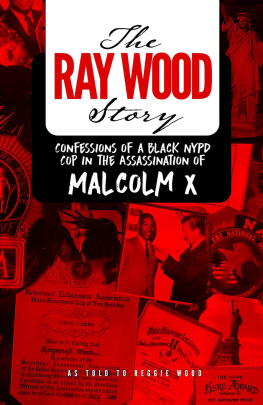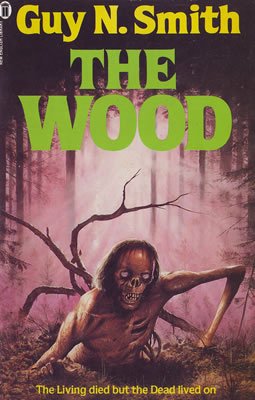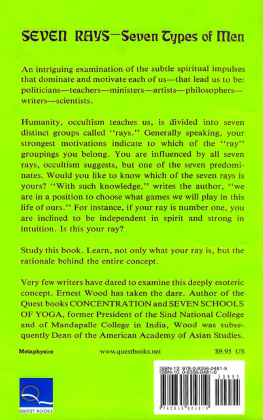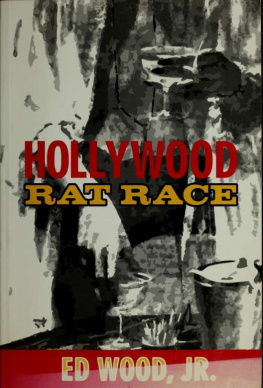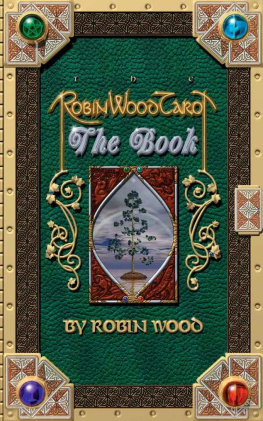Reggie Wood - The Ray Wood Story
Here you can read online Reggie Wood - The Ray Wood Story full text of the book (entire story) in english for free. Download pdf and epub, get meaning, cover and reviews about this ebook. year: 2021, publisher: Madera Enterprises, genre: Home and family. Description of the work, (preface) as well as reviews are available. Best literature library LitArk.com created for fans of good reading and offers a wide selection of genres:
Romance novel
Science fiction
Adventure
Detective
Science
History
Home and family
Prose
Art
Politics
Computer
Non-fiction
Religion
Business
Children
Humor
Choose a favorite category and find really read worthwhile books. Enjoy immersion in the world of imagination, feel the emotions of the characters or learn something new for yourself, make an fascinating discovery.
- Book:The Ray Wood Story
- Author:
- Publisher:Madera Enterprises
- Genre:
- Year:2021
- Rating:4 / 5
- Favourites:Add to favourites
- Your mark:
- 80
- 1
- 2
- 3
- 4
- 5
The Ray Wood Story: summary, description and annotation
We offer to read an annotation, description, summary or preface (depends on what the author of the book "The Ray Wood Story" wrote himself). If you haven't found the necessary information about the book — write in the comments, we will try to find it.
The Ray Wood Story — read online for free the complete book (whole text) full work
Below is the text of the book, divided by pages. System saving the place of the last page read, allows you to conveniently read the book "The Ray Wood Story" online for free, without having to search again every time where you left off. Put a bookmark, and you can go to the page where you finished reading at any time.
Font size:
Interval:
Bookmark:
The
Ray Wood
Story:
Confessions of a Black
NYPD Cop in the
Assassination of Malcolm X
AS TOLD TO REGGIE WOOD
COAUTHORED BY LIZZETTE SALADO
Copyright 2021 Madera Enterprises
All rights reserved. No part of this publication may be reproduced, distributed, or transmitted in any form or by any means, including photocopying, recording, or other electronic mechanical methods, without prior written permission of the publisher, except in the case of brief quotations embodied in critical reviews and certain other noncommercial uses permitted by copyright law.
ISBN: 978-1-7366027-0-6
Library of Congress Control Number: 1-10121603551
Author: Reginald E Wood, Jr.
Coauthor: Lizzette Salado
Cover Designer: Rude Bwoy Graphics & Printing https://www.rudebwoygraphics.com/
Copyeditor: Alan Roberts
www.alanroberts.nyc
Photo Contributor: Angela G. Wood
Research Contributors: L.E.J Rachell (Head of the CORE Legacy Project corenyc.org), Susan Brownmiller, Breonna Nicole Wood
www.theraywoodstory.com
Published by Madera Enterprises
First Printing Edition 2021
In Loving Memory
Raymond A. Wood, 1933-2020.
This short memoir is based on Ray Woods account of his past, shared verbally with me over the course of many in-depth conversations. Ray was explicit in detail, knowingly and clearly asking me to keep a record of his account for the purpose of sharing his confession with the public after his passing. This account is reaffirmed by Ray in his signed confession letter that he left with me. Various articles and papers that discuss Ray, especially in relation to the speculation that surrounded him regarding the Malcolm X assassination, have been referenced throughout the book and are referenced in the bibliography. Other narrative detail, such as dialogue, has been added to help convey Rays story to the reader.
 |  |


By Chenjerai Kumanyika, PhD
Assistant Professor, Rutgers University
Son of Makaza Kumanyika (Herb Callender)
W hen I learned that Ray Wood, a former Black NYPD agent provocateur, had shared his life story, I wasnt sure how to respond. On the orders of the NYPDs Bureau of Special Services and Investigation (BOSSI), Wood infiltrated numerous Black political organizations during the mid to late 1960s. He was recruited specifically to embed himself in their work, surveil them, provoke them into acts of property destruction and violence, entrap them and then testify against them. His first arrest was my father, Herbert Callender, leader of the Bronx chapter of Congress of Racial Equality (CORE). No matter how informed one might be about the ongoing, state-sanctioned violence of police, red squads, or the FBI, this kind of story can and should allow us to feel the rage anew.
Although I felt that Woods family made a courageous and correct choice to write and share his memoir, I wasnt sure if I could muster the emotional endurance to take in the account youre about to read. Ray Wood had the privilege of living a long life with the freedom to tell his story, never having faced accountability. Why should he now be allowed to present himself as a whole person, when his actions helped reduce people we loved, and who loved justice, to violent caricatures?
As painful and infuriating as it might be to look through Ray Woods eyes, I feel his perspective carries essential lessons for those of us who seek to dismantle oppressive systems at their roots. The most important of these lessons from Woods story extend powerfully into the present, offering us essential guidance in the ongoing fight for justice.
First, though Ray Wood bears responsibility for his actions, he was not their ultimate author. His memoir allows us to look more fully at the root of the poisonous tree and see a Black man, born into circumstances he didnt control, who ultimately became a cog in the vast architecture of the repressive U.S. policing apparatus. You will never hear me debate anyone calling Ray Wood Judas, but we should use this metaphor with caution. The illusion that ones ethnicity can be conflated with their political commitment is precisely what allowed Wood to gain entry to so many organizations, so easily. There are obvious lessons here for the 690,000+ officers in the United States today, but not only for them. Despite the efforts of COINTELPRO, Red Squads and agent provocateurs, the victories of the civil rights movement enabled a new wave of Black elites to enter the managerial classes. This meant a change in fortune for their strata, but also placed them as managers in the military, corporations, universities, local government, and the full spectrum of institutions that reproduce and manage black suffering. Therefore, rather than stopping at the label of Judas, it may be more instructive for us to reflect on what his story teaches each of us about navigating our own employers and business partners, and coming to grips with their impact on the lives of Black people and other vulnerable folks.
Let us be clear. Led by J. Edgar Hoover, the FBI and NYPD assigned Ray Wood and other agent provocateurs to infiltrate organizations that were fighting against violence. Those movements were fighting against the violence of systematic racist and capitalist oppression. By Woods own admission, organizers like Malcolm X, my father, and many others were targeted, entrapped, arrested, and attacked for protesting racist hiring practices, segregation, voter suppression, housing practices and the organized violence of police and prisons.
Why then is the state (NYPD, FBI, etc.) so invested in presenting these organizations as violent? The details of Ray Woods recruitment teach us that state-sponsored provocateur-ism was a response to a shift in the movement toward more strategic, effective, and militant non-violent action by a spectrum of Black organizations. Whatever their flaws, groups such as Malcom Xs Organization of African-American Unity (OAAU), CORE, Revolutionary Action Movement (RAM), and the Black Panthers were building powerful domestic and international networks with actions and rhetorical appeals amplifying the systematic racial terror of the United States and making the terms of struggle increasingly clear.
In the face of this justified resistance, then and now, the NYPD, FBI, and other apparatuses of U.S. empire have no ethical, moral, or even constitutional counter argument. Instead, characterizing these movements as violent is an attempt to distract attention from the conditions these organizations were protesting in order to delegitimize them. Only months before the recruitment of Ray Wood, the NYPD strung up and brutally beat Jesse Roberts a Black auto mechanic who reported a stolen car. My father was among the organizers who handcuffed themselves inside the headquarters of police commissioner Michael J. Murphy, demanding justice. Instead of addressing the savage beating of an innocent person, or any person for that matter, police commissioner Murphy responded by claiming he must protect the city against extremist violence. He later clarified he was speaking specifically of Malcom X, Jesse Gray, and my father, Herb Callender.
Ray Wood should not have been surprised to find that the labelling of Black freedom movements as dangerous and violent set the stage for their violent oppression. The blood images of what his work unleashed haunted him until his death. Today, labels like the FBIs Black Identity Extremists reactivate a vast reservoir of centuries of racist representations casting the entire black diaspora as irrationally violent. In the U.S., the modern institution of policing was forged partially from vast slave patrols criminalizing the entire Black population.
Next pageFont size:
Interval:
Bookmark:
Similar books «The Ray Wood Story»
Look at similar books to The Ray Wood Story. We have selected literature similar in name and meaning in the hope of providing readers with more options to find new, interesting, not yet read works.
Discussion, reviews of the book The Ray Wood Story and just readers' own opinions. Leave your comments, write what you think about the work, its meaning or the main characters. Specify what exactly you liked and what you didn't like, and why you think so.

